Application of Vertical Seismic Profiling to Improve Seismic Interpretation of the Rotliegend Formation in Western Poland
Abstract
1. Introduction
2. Geological Background
3. Materials and Methods
3.1. Seismic Data
- Tk—top of the gypsum–anhydrite level within the Keuper profile: positive amplitude,
- Tm—top of the high-velocity Muschelkalk carbonate level: positive amplitude,
- Tp2—contact between the Roethian anhydrite level and the Middle Buntsandstein claystone layer: negative amplitude,
- Zt—top of the Youngest Halite (Na4) corresponding to the top of Zechstein cyclothems sedimentation: negative amplitude,
- Z2—top of the Basal Anhydrite (A2): positive amplitude,
- Zb—base of the Zechstein: negative amplitude.
3.2. VSP Data
3.3. Shape Filter Deconvolution Method
- in time domain:
- in frequency domain:
3.4. Seismic Inversion Method
4. Results
5. Discussion
6. Conclusions
Author Contributions
Funding
Institutional Review Board Statement
Informed Consent Statement
Data Availability Statement
Acknowledgments
Conflicts of Interest
References
- Mitera, Z.A. Present status and future aspects of geophysical exploration in Poland. Geophysics 1939, 3, 225–233. [Google Scholar] [CrossRef]
- Trześniowski, Z. Seismic surveys in historical and contemporary aspect. Przegląd Geol. 1997, 45, 600–604. (In Polish) [Google Scholar]
- Dragoset, B. A historical reflection on reflections. Lead. Edge 2005, 24, 46–70. [Google Scholar] [CrossRef]
- Ashton, C.P.; Bacon, B.; Mann, A.; Moldoveanu, N.; Ireson, D.; Sinclair, T.; Redekop, G. 3D Seismic Survey Design. Oilfield Rev. 1994, 6, 19–32. [Google Scholar]
- Brown, A.R. Interpretation of Three-Dimensional Seismic Data, 5th ed.; AAPG: Tulsa, OK, USA; SEG: Houston, TX, USA, 1999; pp. 1–514. [Google Scholar]
- Vermeer, G. Understanding the fundamentals of 3D seismic survey design. First Break 2001, 19, 130–134. [Google Scholar] [CrossRef]
- Galperin, E.I. Vertical Seismic Profiling and Its Exploration Potential; D. Reidel Publishing Company: Dordrecht, The Netherlands, 2012; pp. 1–442. [Google Scholar] [CrossRef]
- Oristaglio, M.L. A guide to current uses of vertical seismic profiles. Geophysics 1985, 50, 2473–2479. [Google Scholar] [CrossRef]
- Blackburn, J.; Daniels, J.; Dingwall, S.; Hampden-Smith, G.; Leaney, S.; Calvez, J.L.; Nutt, L.; Menkiti, H.; Sanchez, A.; Schinelli, M. Borehole Seismic Surveys: Beyond the Vertical Profile. Oilfield Rev. 2007, 19, 20–35. [Google Scholar]
- Hardage, B.A. Vertical Seismic Profiling: Principles, 3rd ed.; Pergamon: Elmsford, NY, USA, 2000; Volume 14, pp. 1–552. [Google Scholar]
- Stewart, R. VSP: An In-Depth Seismic Understanding. CSEG Rec. 2001, 26, 79–83. [Google Scholar]
- Haldorsen, J.; Milenkovic, M. High-Resolution Processing of VSP Data. In Proceedings of the Fifth EAGE Workshop on Borehole Geophysics, The Hague, The Netherlands, 18–20 November 2019; Volume 2019, pp. 1–5. [Google Scholar] [CrossRef]
- Bulhões, F.C.; Melo, R.J.; Oliveira, R.L.; Diniz, G. Automated detection of faults and fractures in well seismic data in the Campos Basin. In Proceedings of the 17th International Congress of the Brazilian Geophysical Society, Rio de Janeiro, Brazil, 8–11 November 2021; pp. 1–6. [Google Scholar] [CrossRef]
- Maula, F.; Sakina, M.; Trihutomo, H. Integrated Formation Attenuation and Multiple Generator Identification from Multi-well VSP Data. In Proceedings of the 47th Annual Scientific Meeting of Himpunan Ahli Geofisika Indonesia, Malang, Indonesia, 10–13 October 2022; pp. 1–7. [Google Scholar]
- Gomez, G.; Planchart, C.; Chon, Y.; Massimo, A.; Gonzalez, G.; Sifontes, E.; Octavio, D. How integration of well log, core, borehole seismic and cross-well seismic data can offer a powerful tool in complex structural situations. First Break 2002, 20, 404–410. [Google Scholar]
- Payne, M.A.; Eriksen, E.A.; Rape, T.D. Considerations for high-resolution VSP imaging. Lead. Edge 1994, 13, 173–180. [Google Scholar] [CrossRef]
- Stewart, R.; Disiena, J. The values of VSP in interpretation. Lead. Edge 1989, 8, 16–23. [Google Scholar] [CrossRef]
- Wyatt, K.D.; Wyatt, S.B. The determination of subsurface structural information using a vertical seismic profile. In Proceedings of the 51st Annual International Meeting Society of Exploration Geophysicists, Tulsa, OK, USA, 11–15 October1981; Expanded Abstracts. pp. 1915–1949. [Google Scholar]
- Walia, R.; Brandt, K.; Duthie, R.; Whittaker, R.; Malterre, E.; Bell, P. New concepts for borehole and VSP data integration in seismic data processing. First Break 2005, 23, 83–87. [Google Scholar] [CrossRef]
- Castagna, J.P.; Sun, S.; Siegfried, R. Instantaneous spectra analysis: Detection of low-frequency shadows associated with hydrocarbons. Lead. Edge 2003, 22, 120–127. [Google Scholar] [CrossRef]
- Wroblewska, K.; Understanding the Mid North Sea High. GEOExPro. 2017. Available online: https://geoexpro.com/understanding-the-mid-north-sea-high (accessed on 5 September 2025).
- Bajewski, Ł.; Wilk, A.; Urbaniec, A.; Bartoń, R. Improving the imaging of under-Zechstein structures based on the reprocessing of 2D seismic in the West Pomerania region, Poland. Nafta-Gaz 2019, 75, 195–204, (In Polish with English Abstract). [Google Scholar] [CrossRef]
- Fairhead, J.D.; Marsden, D.; Azli, N.M.; Özsöz, I.; Maxwell, D.; Rose, O.; Green, C.M. Gravity imaging of sub-Zechstein geological structures in the UK sector of the North Sea using the gravity layer stripping method. Pet. Geosci. 2023, 29, petgeo2023-009. [Google Scholar] [CrossRef]
- Chopra, S.; Alexeev, V.; Sudhakar, V. High-frequency restoration of surface seismic data. Lead. Edge 2003, 22, 730–738. [Google Scholar] [CrossRef]
- Bartoń, R.; Jędrzejowska, H.; Żukowska, K. Application of Vertical Seismic Profiling for improvement of seismic surface data resolution. Case study from Carpathian Foreland in Poland. In Proceedings of the VII Annual International Conference and Exhibition—Galperin Readings, Moscow, Russia, 28–31 October 2007. [Google Scholar] [CrossRef]
- Bartoń, R. Quantitative and qualitative effects of increasing resolution of seismic sections in the geological interpretation of seismic data as a result of the measurements in regard to vertical seismic profiling. Pr. Nauk. INiG 2010, 169, 1–124, (In Polish with English Abstract). [Google Scholar]
- Karnkowski, P.H. Origin and evolution of the Polish Rotliegend Basin. Polish Geol. Inst. Sp. Pap. 1999, 3, 1–93. [Google Scholar]
- Van Uijen, W.M. Rotliegend Geology in the Southern Permian Basin: The Development of Synrift Sediments and Its Relation to Seismic Imaging; Utrecht University: Utrecht, The Netherlands, 2013. [Google Scholar]
- Oszczepalski, S.; Speczik, S.; Zieliński, K.; Chmielewski, A. The Kupferschiefer Deposits and Prospects in SW Poland: Past, Present and Future. Minerals 2019, 9, 592. [Google Scholar] [CrossRef]
- Kiersnowski, H.; Buniak, A. Sand sheets interaction with aeolian dune, alluvial and marginal playa beds in Late Permian Upper Rotliegend setting (western part of the Poznań Basin, Poland). Geol. Q. 2016, 60, 771–800. [Google Scholar] [CrossRef]
- Ryka, W. Precambrian evolution of the Polish part of the East-European Platform in Poland. Geol. Q. 1982, 26, 257–272, (In Polish with English Abstract). [Google Scholar]
- Dadlez, R. The Polish Basin—Relationship between the crystalline, consolidated and sedimentary crust. Geol. Q. 2006, 50, 43–58. [Google Scholar]
- Bogdanova, S.V.; Bingen, B.; Gorbatschev, R.; Kheraskova, T.N.; Kozlov, V.I.; Puchkov, V.N.; Volozh, Y.A. The East European Craton (Baltica) before and during the assembly of Rodinia. Precambrian Res. 2008, 60, 23–45. [Google Scholar] [CrossRef]
- Poprawa, P. Geological setting and Ediacaran–Palaeozoic evolution of the western slope of the East European Craton and adjacent regions. Ann. Soc. Geol. Pol. 2019, 89, 347–380. [Google Scholar] [CrossRef]
- Jóźwiak, W.; Nowożyński, K.; Mazur, S.; Jeż, M. Deep Electrical Resistivity Structure of the European Lithosphere in Poland Derived from 3-D Inversion of Magnetotelluric Data. Surv. Geophys. 2022, 43, 1563–1586. [Google Scholar] [CrossRef]
- Żelaźniewicz, A.; Aleksandrowski, P.; Buła, Z.; Karnkowski, P.H.; Konon, A.; Oszczypko, N.; Ślączka, A.; Żaba, J.; Żytko, K. Tectonic Subdivision of Poland; Komitet Nauk Geologicznych PAN: Wrocław, Poland, 2011; pp. 1–60. (In Polish) [Google Scholar]
- Narkiewicz, M.; Petecki, Z. Basement structure of the Paleozoic Platform in Poland. Geol. Q. 2017, 61, 502–520. [Google Scholar] [CrossRef]
- Nguyen, Q.; Malinowski, M.; Mazur, S.; Stovba, S.; Ponikowska, M.; Hübscher, C. Post-Caledonian tectonic evolution of the Precambrian and Paleozoic platform boundary zone offshore Poland based on the new and vintage multi-channel reflection seismic data. Solid Earth 2024, 15, 1029–1046. [Google Scholar] [CrossRef]
- Kłapciński, J.; Muszer, J. Age of pre-Permian rocks from chosen boreholes of eastern part of the Fore-Sudetic Monocline. Geol. Sudet. 1987, 22, 91–100, (In Polish with English Abstract). [Google Scholar]
- Wierzchowska-Kicułowa, K. Geological features of the Permian basement in the Fore-Sudetic area. Geol. Q. 1987, 31, 557–568, (In Polish with English Abstract). [Google Scholar]
- Górecka-Nowak, A. New interpretations of the Carboniferous stratigraphy of SW Poland based on miospore data. Bull. Geosci. 2008, 83, 101–116. [Google Scholar] [CrossRef]
- Maliszewska, A.; Kiersnowski, H.; Jackowicz, E. Volcanoclastic deposits of the Lower Rotliegend in the Wielkopolska region. Prace Państw. Inst. Geol. 2003, 179, 1–59, (In Polish with English Abstract). [Google Scholar]
- Maliszewska, A.; Jackowicz, E.; Kuberska, M.; Kiersnowski, H. Lower Permian (Rotliegend) rocks of Western Poland—A petrographic monograph. Prace Państw. Inst. Geol. 2016, 204, 6–115, (In Polish with English Abstract). [Google Scholar]
- Kiersnowski, H. Depositional development of the Polish Upper Rotliegend Basin and evolution of its sediment source areas. Geol. Q. 1997, 41, 433–456. [Google Scholar]
- Kiersnowski, H. Late Permian aeolian sand seas from the Polish Upper Rotliegend Basin in the context of palaeoclimatic periodicity. Geol. Soc. Sp. Publ. 2013, 376, 431–456. [Google Scholar] [CrossRef]
- Buniak, A.; Kuberska, M.; Kiersnowski, H. Petrographical-petrophysical characteristics of the Rotliegend eolian sandstones of the Siekierki–Winna Góra Zone (the Poznań region) in the aspect of search for gas trapped in deposits. Przegląd Geol. 2009, 57, 328–334, (In Polish with English Abstract). [Google Scholar]
- Wagner, R.; Piątkowski, T.S.; Peryt, T.M. Polish Zechstein Basin. Przegląd Geol. 1978, 26, 673–686, (In Polish with English Abstract). [Google Scholar]
- Wagner, R. The evolution of the Zechstein Basin in Poland. Geol. Q. 1988, 32, 33–52, (In Polish with English Abstract). [Google Scholar]
- Tucker, M.E. Sequence stratigraphy of carbonate-evaporite basins, models and application to the Upper Permian (Zechstein) of northeast England and adjoining North Sea. J. Geol. Soc. 1991, 148, 1019–1036. [Google Scholar] [CrossRef]
- Kiersnowski, H.; Paul, J.; Peryt, T.M.; Smith, D.B. Facies, Paleogeography, and Sedimentary History of the Southern Permian Basin in Europe. In The Permian of Northern Pangea; Scholle, P.A., Peryt., T.M., Ulmer-Scholle, D.S., Eds.; Springer: Berlin/Heidelberg, Germany, 1995. [Google Scholar] [CrossRef]
- Wagner, R.; Peryt, T.M. Possibility of sequence stratigraphic subdivison of the Zechstein in the Polish Basin. Geol. Q. 1997, 41, 457–474. [Google Scholar]
- Becker, F.; Bechstädt, T. Sequence stratigraphy of a carbonate-evaporite succession (Zechstein 1, Hessian Basin, Germany). Sedimentology 2006, 53, 1083–1120. [Google Scholar] [CrossRef]
- Richter-Bernburg, G. Stratigraphische Gliederung des deutschen Zachsteins. Z. Deutsch. Geol. Ges. 1955, 105, 843–854. [Google Scholar]
- Gajewska, I. Middle Triassic (Muschelkalk–Lower Keuper). In The Epicontinental Permian and Mesozoic in Poland; Marek, S., Pajchlowa, M., Ulmer-Scholle, D.S., Eds.; Prace Panstwowego Instytutu Geologicznego: Warsaw, Poland, 1997; Volume 153, pp. 144–150. (In Polish) [Google Scholar]
- Pieńkowski, G. The epicontinental Lower Jurassic of Poland. Pol. Geol. Inst. Sp. Papers 2004, 12, 5–154. [Google Scholar]
- Karnkowski, P.H. Permian Basin as a main exploration target in Poland. Przegląd Geol. 2007, 55, 1003–1015. [Google Scholar]
- Papiernik, B.; Doligez, B.; Klimkowski, Ł. Structural and Parametric Models of the Załecze and Zuchlów Gas Field Region, Fore-Sudetic Monocline, Poland—An Example of a General Static Modeling Workflow in Mature Petroleum Areas for CCS, EGR or EOR Purposes. Oil Gas Sci. Technol. Rev. IFP Energ. Nouv. 2015, 70, 635–654. [Google Scholar] [CrossRef]
- Zając, A.; Maćkowski, T. Reservoir interpretation of Rotliegend seismic reflections in the central part of the Mid-Polish Trough. Mar. Pet. Geol. 2018, 89, 300–312. [Google Scholar] [CrossRef]
- Dohnalik, M.; Zalewska, J. Correlation of results of laboratory tests obtained by X-ray microtomography, nuclear magnetic resonance and mercury porosimetry. Nafta-Gaz 2013, 69, 735–743. (In Polish) [Google Scholar]
- Dubiel, A.; Rybicki, C.; Zubrzycki, A.; Maruta, M. Applicability of DST results to the evaluation of changes of geologic conditions of Rotliegend series in the Polish Lowland. AGH Drill. Oil Gas 2015, 32, 77–88. [Google Scholar] [CrossRef]
- Dohnalik, M.; Ziemianin, K. Characteristics of Rotliegend sediments in view of X-ray microtomohraphy and optical microscopy investigations. Nafta-Gaz 2020, 76, 765–773, (In Polish with English Abstract). [Google Scholar] [CrossRef]
- Hope, R.; Ireson, D.; Leaney, S.; Meyer, J.; Tittle, W.; Willis, M. Seismic Integration to Reduce Risk. Oilfield Rev. 1998, 10, 2–15. [Google Scholar]
- Gulati, J.S.; Stewart, R.R.; Parkin, J.M. Analyzing three-component 3D vertical seismic profiling data. Geophysics 2004, 69, 386–392. [Google Scholar] [CrossRef]
- Tabakov, A.A.; Ferentsi, V.N. Principles and Techniques of VSP Data Processing. In Proceedings of the 9th Simposio Bolivariano—Exploracion Petrolera en las Cuencas Subandinas, Cartagena, Colombia, 24–27 September 2006]; p. cp-111-00006. [Google Scholar] [CrossRef]
- Bartoń, R. Role of VSP measurement in investigation of anisotropy of geological medium. In Proceedings of the XI Annual International Conference and Exhibition—Galperin Readings, Moscow, Russia, 24–28 October 2011; pp. 1–5. [Google Scholar]
- Bartoń, R. Determination of directional velocity changes of transverse waves in near-wellbore zone based on VSP 3C. Nafta-Gaz 2014, 70, 483–492, (In Polish with English Abstract). [Google Scholar]
- Bartoń, R. Application of the shape filter deconvolution to improve the resolution of seismic data. Nafta-Gaz 2014, 70, 861–867, (In Polish with English abstract). [Google Scholar]
- Jędrzejowska-Tyczkowska, H.; Żukowska, K. Increasing resolution of seismic section to enhance of quantitative estimates reliability of physical parameters of a medium. Nafta-Gaz 1999, 55, 334–346, (In Polish with English Abstract). [Google Scholar]
- Pendrel, J. Seismic Inversion—A Critical Toll in Reservoir Characterization. Scand. Oil-Gas Mag. 2006, 34, 19–22. [Google Scholar]
- Russell, B.H. Introduction to Seismic Inversion Methods; Society of Exploration Geophysicists: Houston, TX, USA, 1988; pp. 1–178. [Google Scholar] [CrossRef]
- Helland-Hansen, D.; Magnus, I.; Edvardsen, A.; Hansen, E. Seismic Inversion for Reservoir Characterization and Well Planning in the Snorre Field. Lead. Edge 1997, 16, 269–274. [Google Scholar] [CrossRef]
- Veeken, P.C.H.; Silva, M. Seismic inversion methods and some of their constraints. First Break 2004, 22, 15–38. [Google Scholar]
- Jędrzejowska-Zwinczak, H. Seismic inversion of longitudinal, shear and converted waves for selected problem of reservoir interpretation. Pr. Nauk. INiG 2009, 160, 1–85, (In Polish with English Abstract). [Google Scholar]
- Cooke, D.A.; Schneider, W.A. Generalized linear inversion of reflection seismic data. Geophysics 1983, 48, 665–675. [Google Scholar] [CrossRef]
- Hendrick, N.; Hearn, S. Evaluation of Seismic Trace Inversion Techniques. Explor. Geophys. 1993, 24, 549–559. [Google Scholar] [CrossRef]
- Wang, J.; Liu, Y.; Sun, Z.; Tian, H.; Su, H.; Zhao, Q.; Liu, Y. Acoustic impedance inversion of zero-offset VSP data. Appl. Geophys. 2009, 6, 150–158. [Google Scholar] [CrossRef]
- Bartoń, R. Calculation of seismic inversion on VSP-CDP azimuthal transformations of longitudinal and transverse waves. Nafta-Gaz 2015, 71, 711–719, (In Polish with English Abstract). [Google Scholar] [CrossRef]
- Jaworowski, K.; Mikołajewski, Z. Oil- and gas-bearing sediments of the Main Dolomite (Ca2) in the Miedzychód region: A depositional model and the problem of the boundary between the second and third depositional sequences in the Polish Zechstein Basin. Przegląd Geol. 2007, 55, 1017–1024. [Google Scholar]
- Maćkowski, T.; Kwolek, K.; Górecki, W. The potential for locating hydrocarbon traps in the Rotliegend formation, based on the results of experimental seismic surveys. Geol. Geophys. Environ. 2017, 43, 191–199. [Google Scholar] [CrossRef]
- Van Hulten, F.F.N. Geological factors effecting compartmentalization of Rotliegend gas fields in the Netherlands. Geol. Soc. 2010, 347, 301–315. [Google Scholar] [CrossRef]
- Bensea, F.A.; Jähne-Klingberga, F. Storage potentials in the deeper subsurface of the Central German North Sea. Energy Procedia 2017, 114, 4595–4622. [Google Scholar] [CrossRef]
- Sorento, T.; Stemmerik, L.; Olaussen, S. Upper Permian carbonates at the northern edge of the Zechstein basin, Utsira High, Norwegian North Sea. Mar. Pet. Geol. 2018, 89, 635–652. [Google Scholar] [CrossRef]
- Poszytek, A. Reservoir properties of the Upper Rotliegend and the Weissliegend sandstones (Permian) in the Zielona Góra Basin (western Poland). Geol. Q. 2014, 58, 193–206. [Google Scholar] [CrossRef]
- De Freslon, N.; Cuilhe, L.; Yareshchenko, S.; Solodkyi, Y.; Gafych, I.; Rudling, C.; Lucet, N.; Desgoutte, N.; Machault, V. Integration of VSP in the process of surface seismic data inversion. First Break 2021, 39, 35–44. [Google Scholar] [CrossRef]
- Henninges, J.; Martuganova, E.; Stiller, M.; Norden, B.; Krawczyk, C.M. Wireline distributed acoustic sensing allows 4.2 km deep vertical seismic profiling of the Rotliegend 150 °C geothermal reservoir in the North German Basin. Solid Earth 2021, 12, 521–537. [Google Scholar] [CrossRef]
- Mullen, R.; Barry, B.; Rudling, C.; Bailey, J.; Solodkyi, Y.; Yareshchenko, S.; Gafych, I.; Wills, W. Collaborative VSP acquisition to optimize imaging for field development. First Break 2021, 39, 45–51. [Google Scholar] [CrossRef]
- Egorov, A.; Pevzner, R.; Bóna, A.; Glubokovskikh, S.; Puzyrev, V.; Tertyshnikov, K.; Gurevich, B. Time-lapse full waveform inversion of vertical seismic profile data: Workflow and application to the CO2CRC Otway project. Geophys. Res. Lett. 2017, 44, 7211–7218. [Google Scholar] [CrossRef]
- Wang, Y.; Lawton, D.C. Time-Lapse Impedance Variations Using DAS VSP Data During CO2 Injection at the CMC Newell County Facility, Alberta, Canada; SEG Technical Program Expanded Abstracts; SEG: Houston, TX, USA, 2023; pp. 1750–1754. [Google Scholar] [CrossRef]
- Cao, D.; Jia, Y.; Cuia, R. VSP Wavefiled Separation Using GAN Base on Asymmetric Convolution Blocks; SEG Technical Program Expanded Abstracts; SEG: Houston, TX, USA, 2021; pp. 3530–3535. [Google Scholar] [CrossRef]
- Yinling Guo, Y.; Peng, S.; Du, W.; Li, D. Denoising and wavefield separation method for DAS VSP via deep learning. J. Appl. Geophys. 2023, 210, 104946. [Google Scholar] [CrossRef]
- Xiaobin Li, X.; Qi, Q.; Li, L.; Duan, P.; Li, L.; Meng, J.; Zheng, M. A big data-driven deep-learning method for seismic wavefield separation of vertical seismic profile data. Geophysics 2025, 90, 439–454. [Google Scholar] [CrossRef]

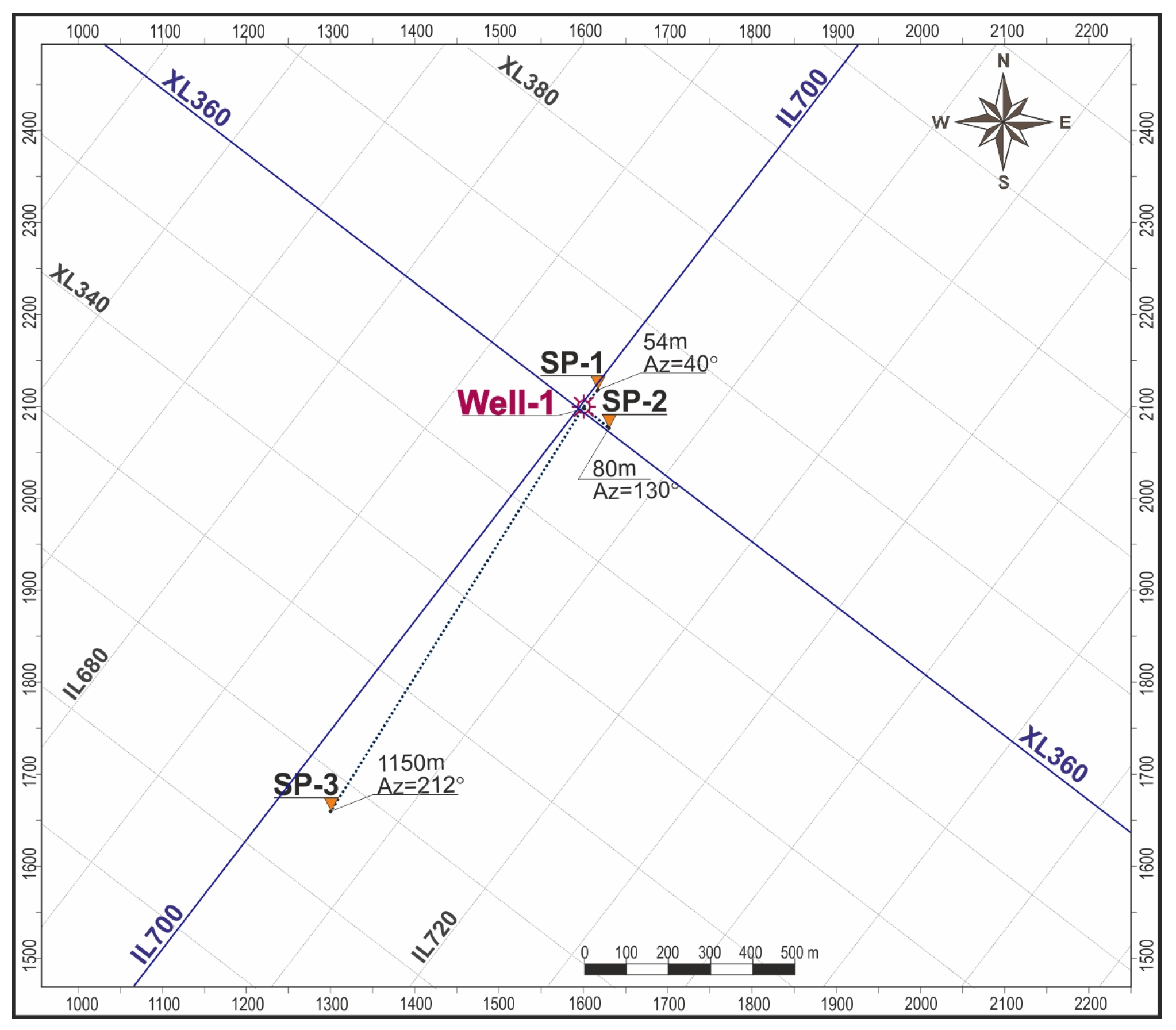
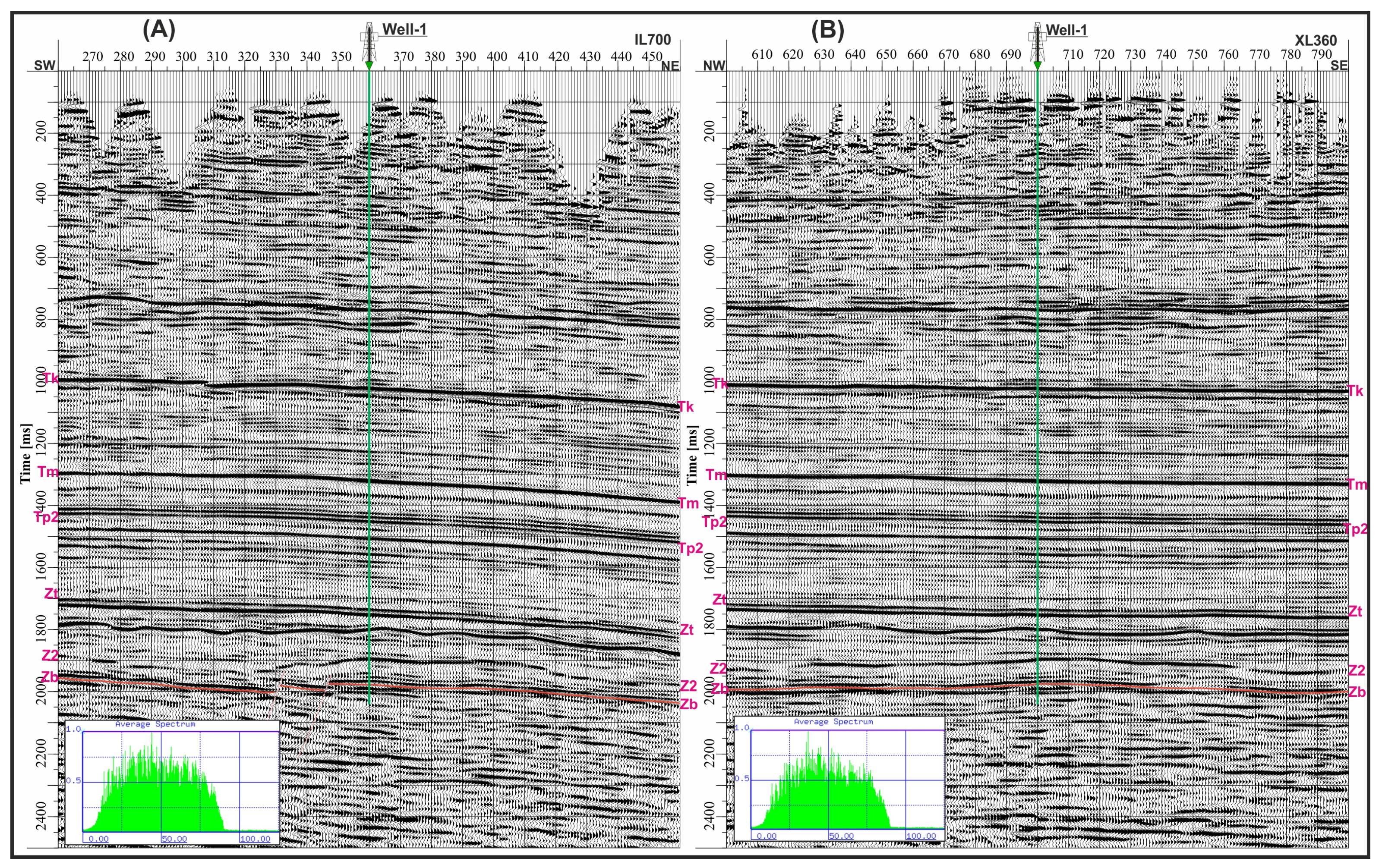
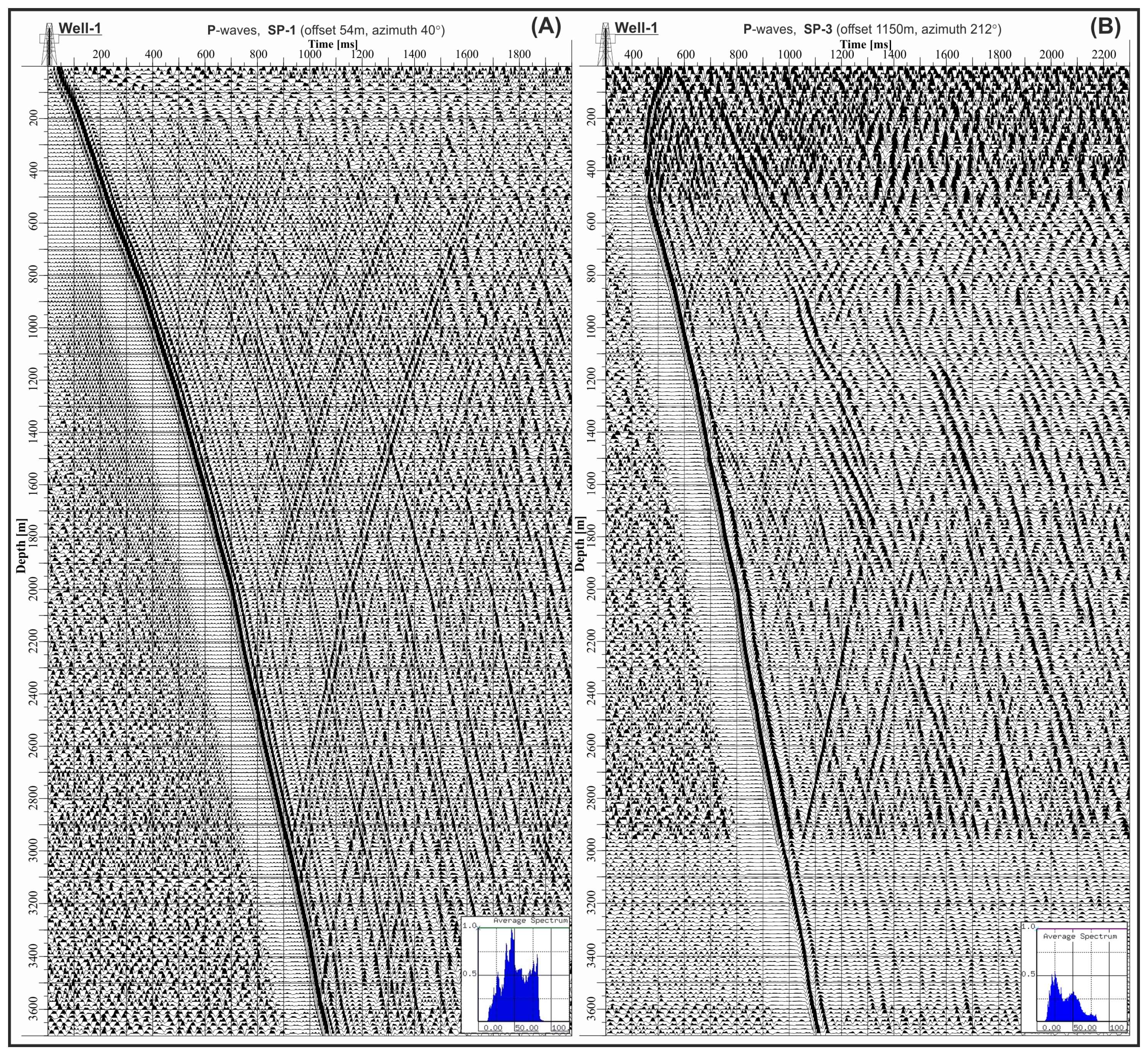
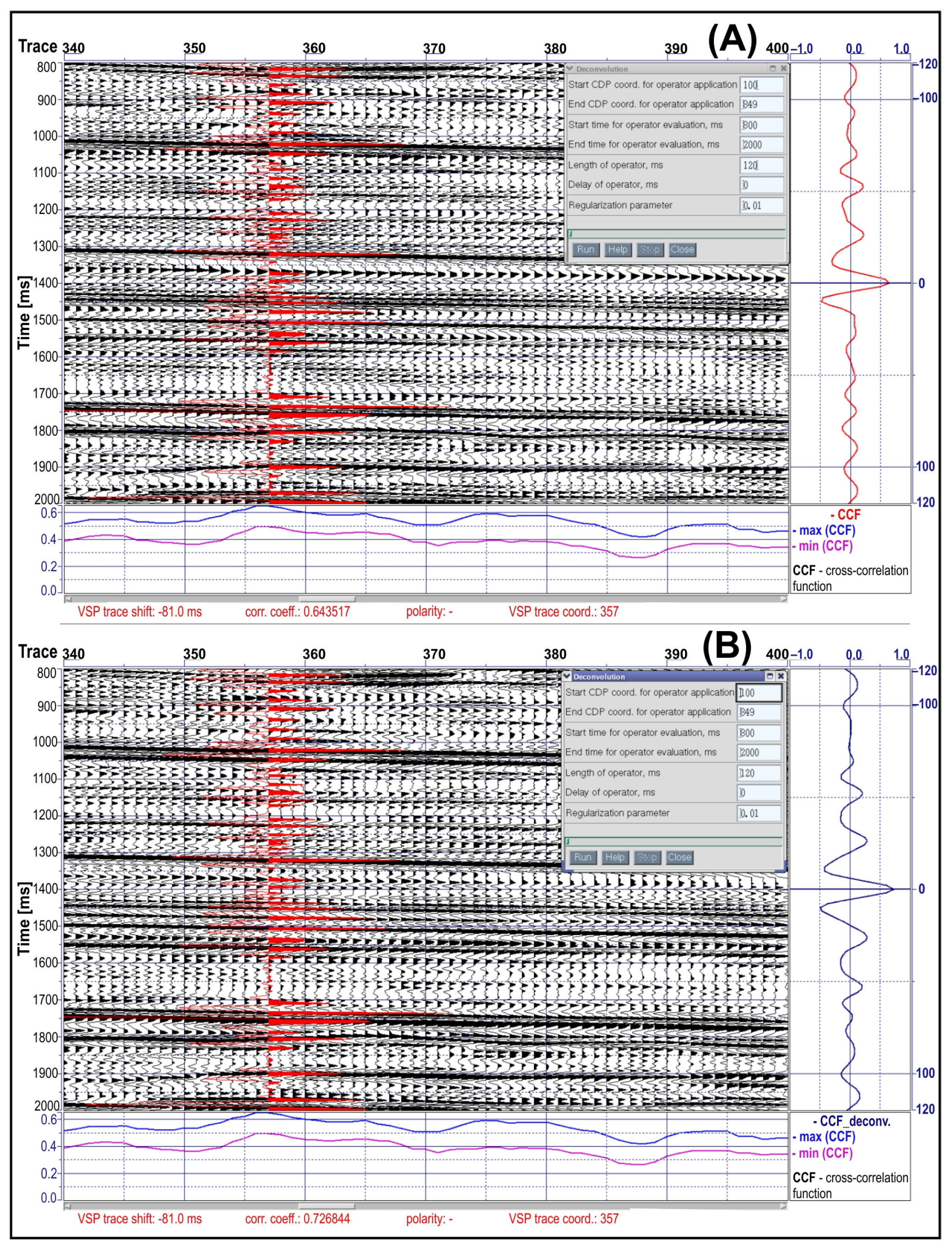

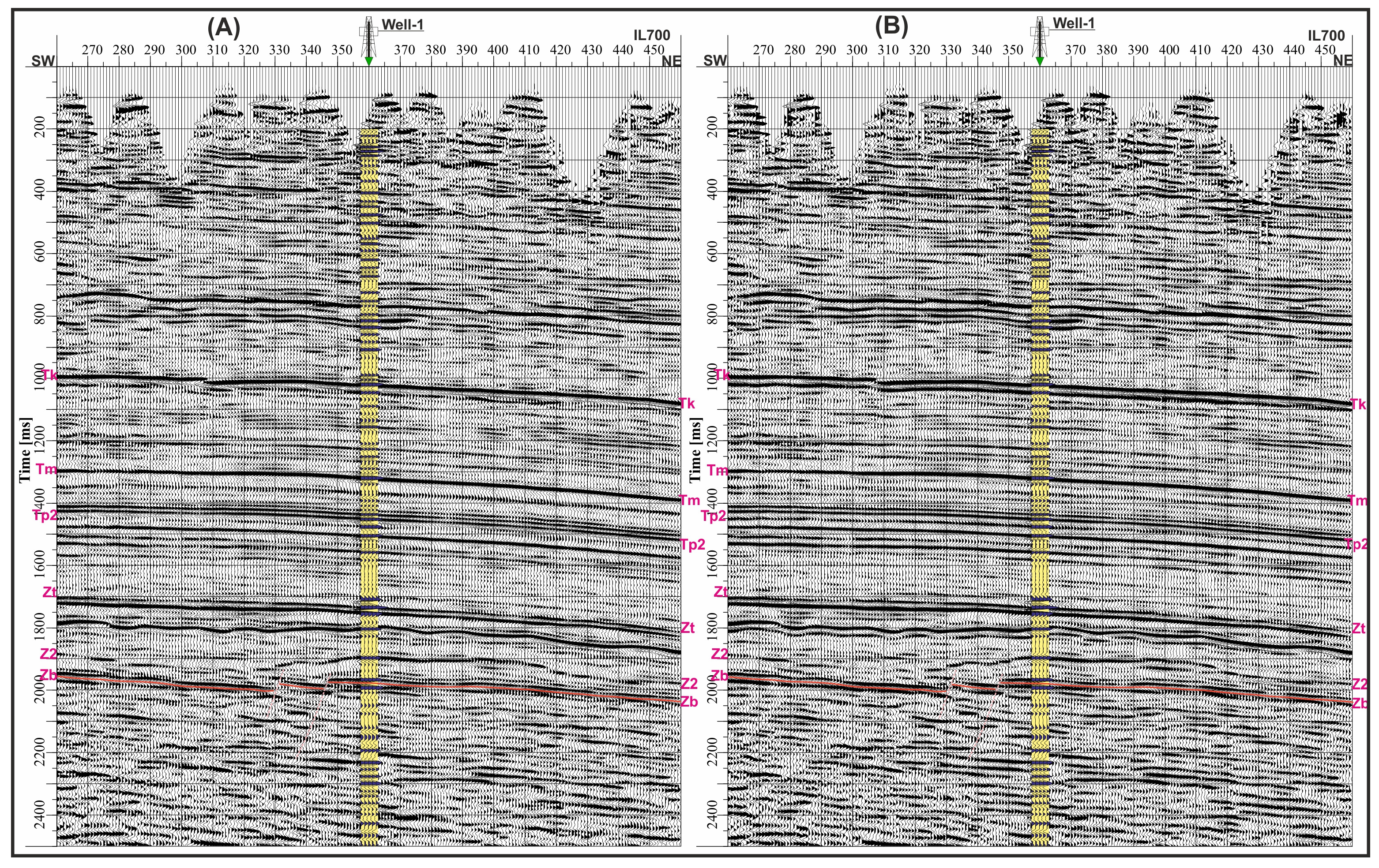
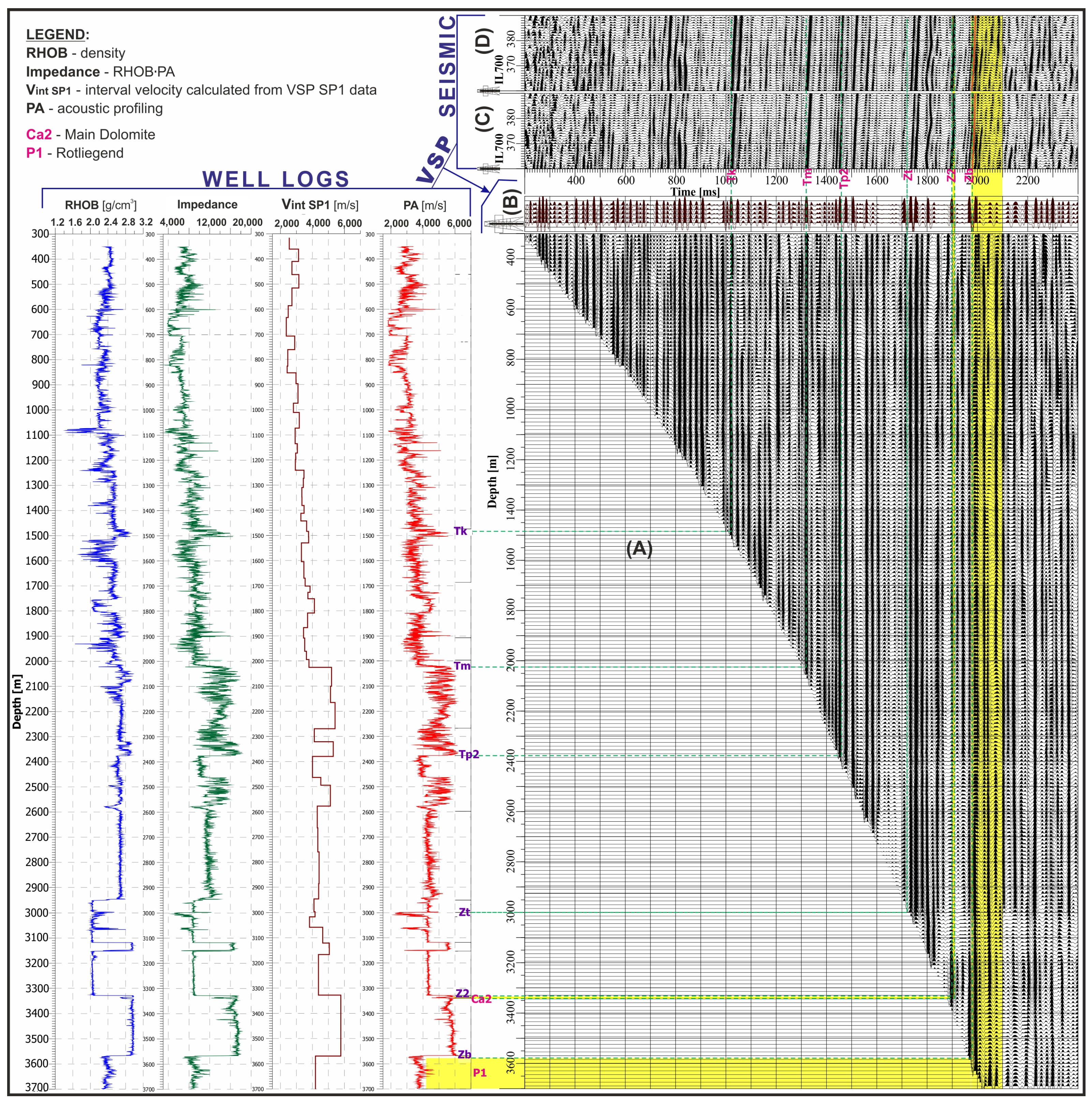


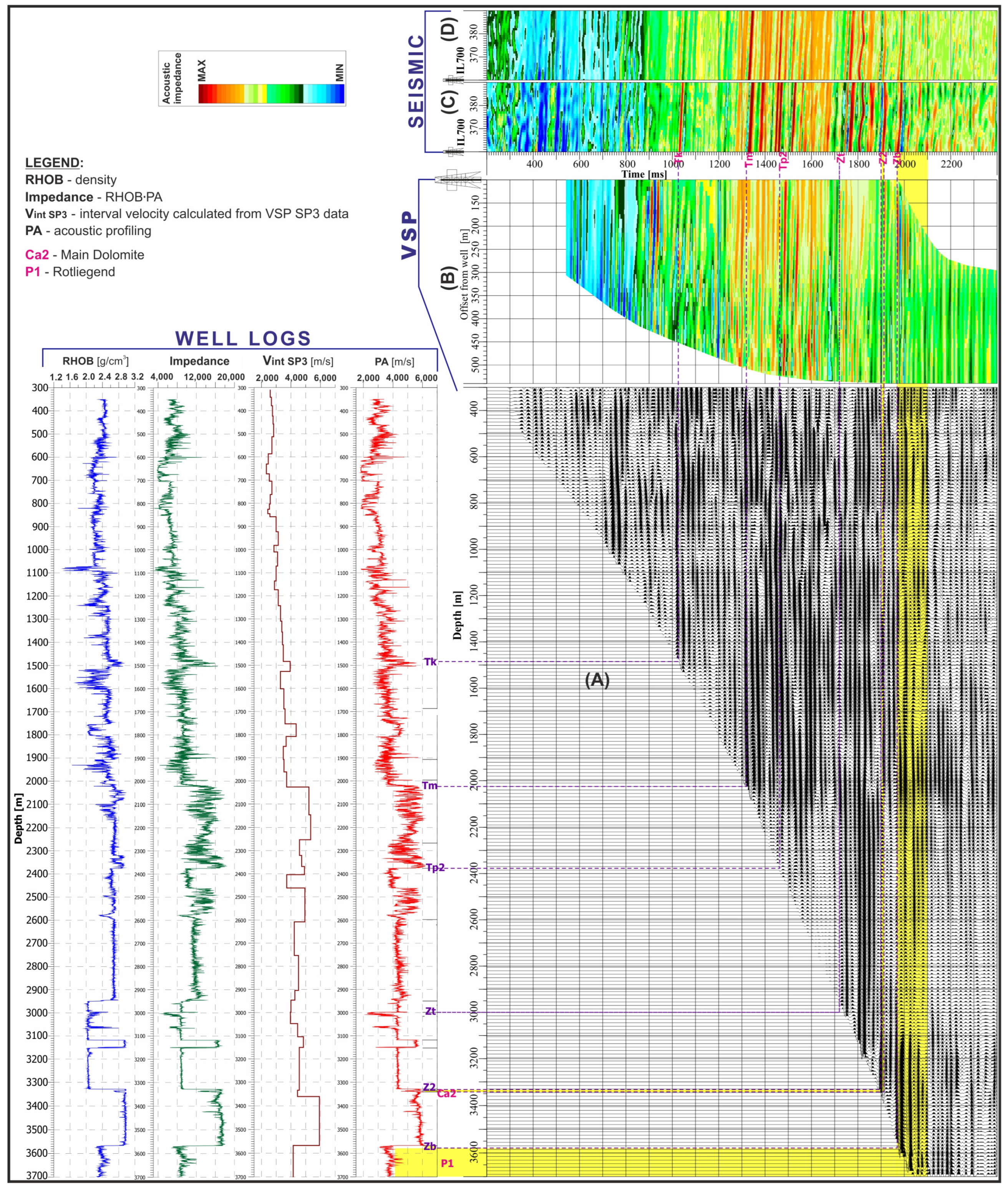
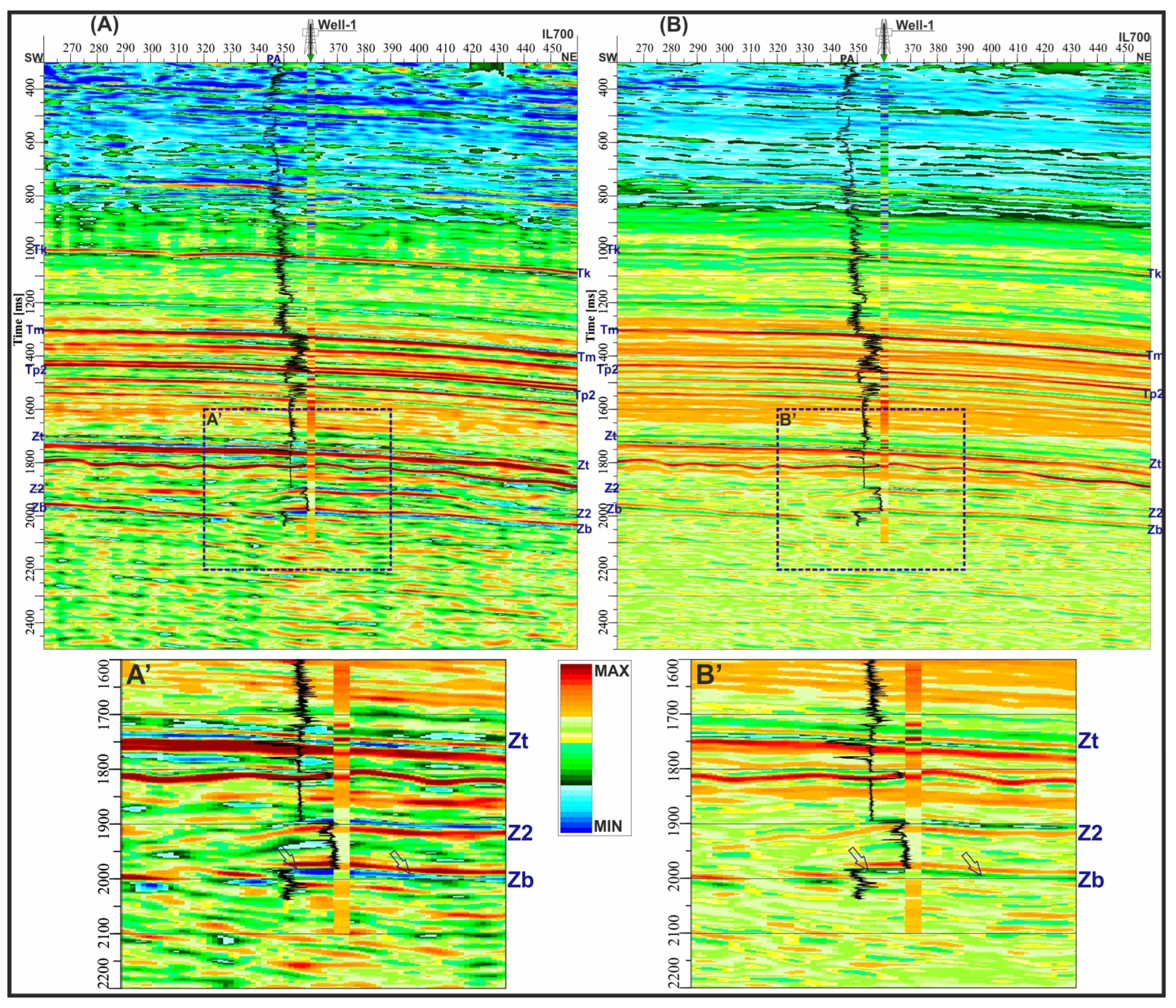
Disclaimer/Publisher’s Note: The statements, opinions and data contained in all publications are solely those of the individual author(s) and contributor(s) and not of MDPI and/or the editor(s). MDPI and/or the editor(s) disclaim responsibility for any injury to people or property resulting from any ideas, methods, instructions or products referred to in the content. |
© 2025 by the authors. Licensee MDPI, Basel, Switzerland. This article is an open access article distributed under the terms and conditions of the Creative Commons Attribution (CC BY) license (https://creativecommons.org/licenses/by/4.0/).
Share and Cite
Bartoń, R.; Urbaniec, A.; Łaba-Biel, A. Application of Vertical Seismic Profiling to Improve Seismic Interpretation of the Rotliegend Formation in Western Poland. Appl. Sci. 2025, 15, 11339. https://doi.org/10.3390/app152111339
Bartoń R, Urbaniec A, Łaba-Biel A. Application of Vertical Seismic Profiling to Improve Seismic Interpretation of the Rotliegend Formation in Western Poland. Applied Sciences. 2025; 15(21):11339. https://doi.org/10.3390/app152111339
Chicago/Turabian StyleBartoń, Robert, Andrzej Urbaniec, and Anna Łaba-Biel. 2025. "Application of Vertical Seismic Profiling to Improve Seismic Interpretation of the Rotliegend Formation in Western Poland" Applied Sciences 15, no. 21: 11339. https://doi.org/10.3390/app152111339
APA StyleBartoń, R., Urbaniec, A., & Łaba-Biel, A. (2025). Application of Vertical Seismic Profiling to Improve Seismic Interpretation of the Rotliegend Formation in Western Poland. Applied Sciences, 15(21), 11339. https://doi.org/10.3390/app152111339





